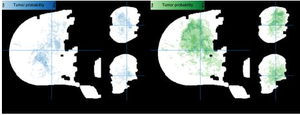Information
- Publication Type: Master Thesis
- Workgroup(s)/Project(s):
- Date: May 2018
- Date (Start): 1. August 2017
- Date (End): 25. May 2018
- TU Wien Library:
- First Supervisor:
- Keywords: comparative visual analytics, breast cancer
Abstract
The most common cancer among the female population in the economically developed world is breast cancer. To significantly reduce the mortality among affected women, an early diagnosis is essential, and also treatment strategies need to be selected carefully. Clinical researchers working on the selection of chemotherapy treatment need to analyze the progress of the disease during and after treatment and to understand how different groups of patients respond to selected treatments. Currently this is a difficult task because of the multitude of involved (imaging and non-imaging) data, for which adequate visualizations are required. The aim of this work is to help clinical researchers working on the analysis of the progress of chemotherapy to understand and explore the multitude of data they have. This thesis introduces a web-based framework realizing three tasks of exploring and analyzing imaging and non-imaging data of breast cancer patients in a cohort. A functionality for single patient follow-up studies (intra-patient study), a functionality to compare two different patients (pairwise inter-patient study) and a functionality to compare groups of patients (groupwise inter-patient study) are provided to enable an easier exploration and analysis of the available multivariate cohort data. To begin with, the imaging and non-imaging data underwent some preprocessing steps, such as registration, segmentation and calculation of tumor probability maps, to make them comparable. Afterwards, we carefully designed and implemented several multiple linked views, where interactive representations show distinct aspects of the data from which the clinical researcher can understand and analyze the available cohort data. A number of use cases to demonstrate the results that can be achieved with the provided framework are performed and they illustrate the functionality and also the importance of the designed and implemented visual analytics framework. Using this framework, clinical researchers are able to visually explore and analyze the multitude of both imaging and non-imaging data of a patient and compare patients within a cohort, which was not possible before with any available exploratory tools.Additional Files and Images
Weblinks
BibTeX
@mastersthesis{Karall2017CVAB,
title = "Comparative Visual Analytics in a Cohort of Breast Cancer
Patients",
author = "Nikolaus Karall",
year = "2018",
abstract = "The most common cancer among the female population in the
economically developed world is breast cancer. To
significantly reduce the mortality among affected women, an
early diagnosis is essential, and also treatment strategies
need to be selected carefully. Clinical researchers working
on the selection of chemotherapy treatment need to analyze
the progress of the disease during and after treatment and
to understand how different groups of patients respond to
selected treatments. Currently this is a difficult task
because of the multitude of involved (imaging and
non-imaging) data, for which adequate visualizations are
required. The aim of this work is to help clinical
researchers working on the analysis of the progress of
chemotherapy to understand and explore the multitude of data
they have. This thesis introduces a web-based framework
realizing three tasks of exploring and analyzing imaging and
non-imaging data of breast cancer patients in a cohort. A
functionality for single patient follow-up studies
(intra-patient study), a functionality to compare two
different patients (pairwise inter-patient study) and a
functionality to compare groups of patients (groupwise
inter-patient study) are provided to enable an easier
exploration and analysis of the available multivariate
cohort data. To begin with, the imaging and non-imaging data
underwent some preprocessing steps, such as registration,
segmentation and calculation of tumor probability maps, to
make them comparable. Afterwards, we carefully designed and
implemented several multiple linked views, where interactive
representations show distinct aspects of the data from which
the clinical researcher can understand and analyze the
available cohort data. A number of use cases to demonstrate
the results that can be achieved with the provided framework
are performed and they illustrate the functionality and also
the importance of the designed and implemented visual
analytics framework. Using this framework, clinical
researchers are able to visually explore and analyze the
multitude of both imaging and non-imaging data of a patient
and compare patients within a cohort, which was not possible
before with any available exploratory tools.",
month = may,
address = "Favoritenstrasse 9-11/E193-02, A-1040 Vienna, Austria",
school = "Institute of Computer Graphics and Algorithms, Vienna
University of Technology ",
keywords = "comparative visual analytics, breast cancer",
URL = "https://www.cg.tuwien.ac.at/research/publications/2018/Karall2017CVAB/",
}

 image
image Master Thesis
Master Thesis

